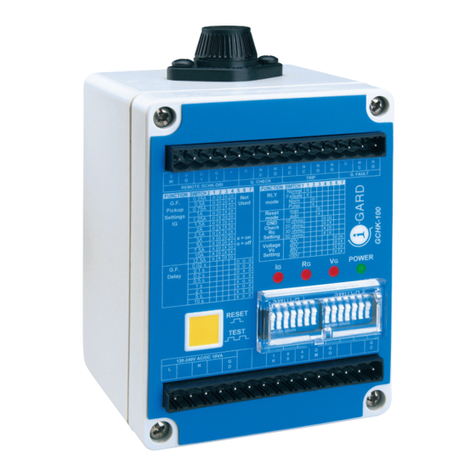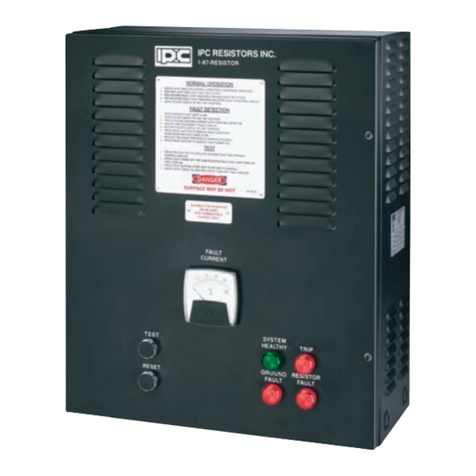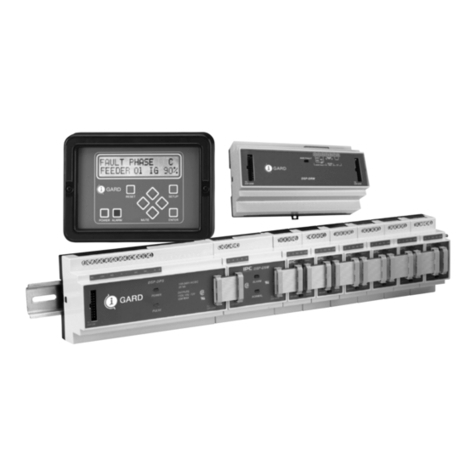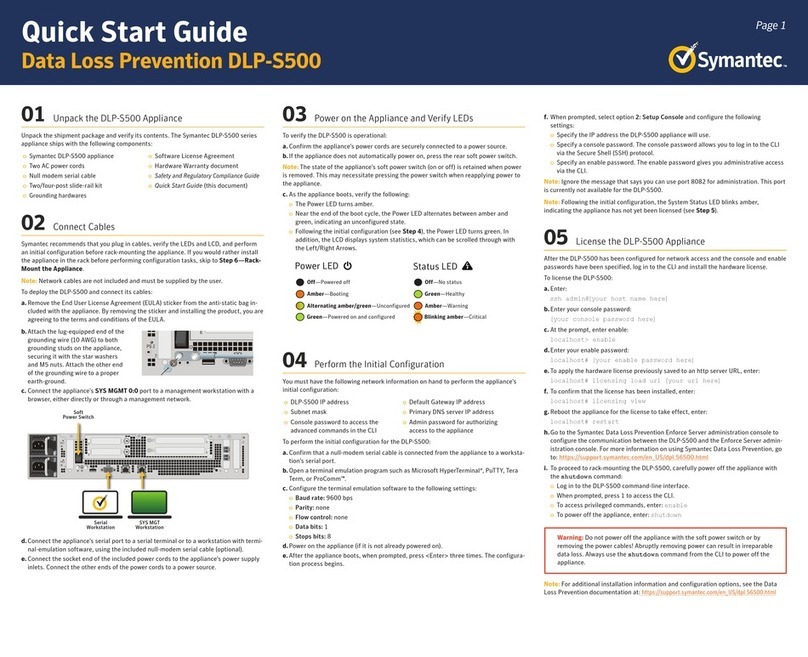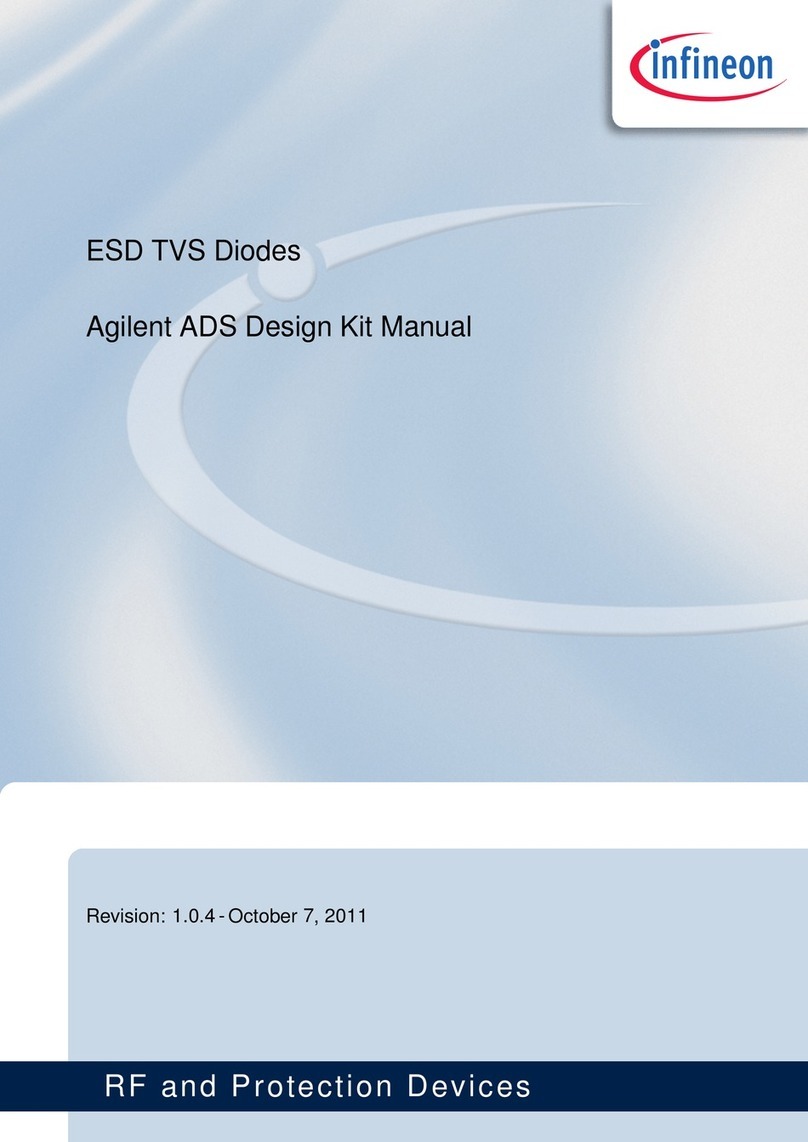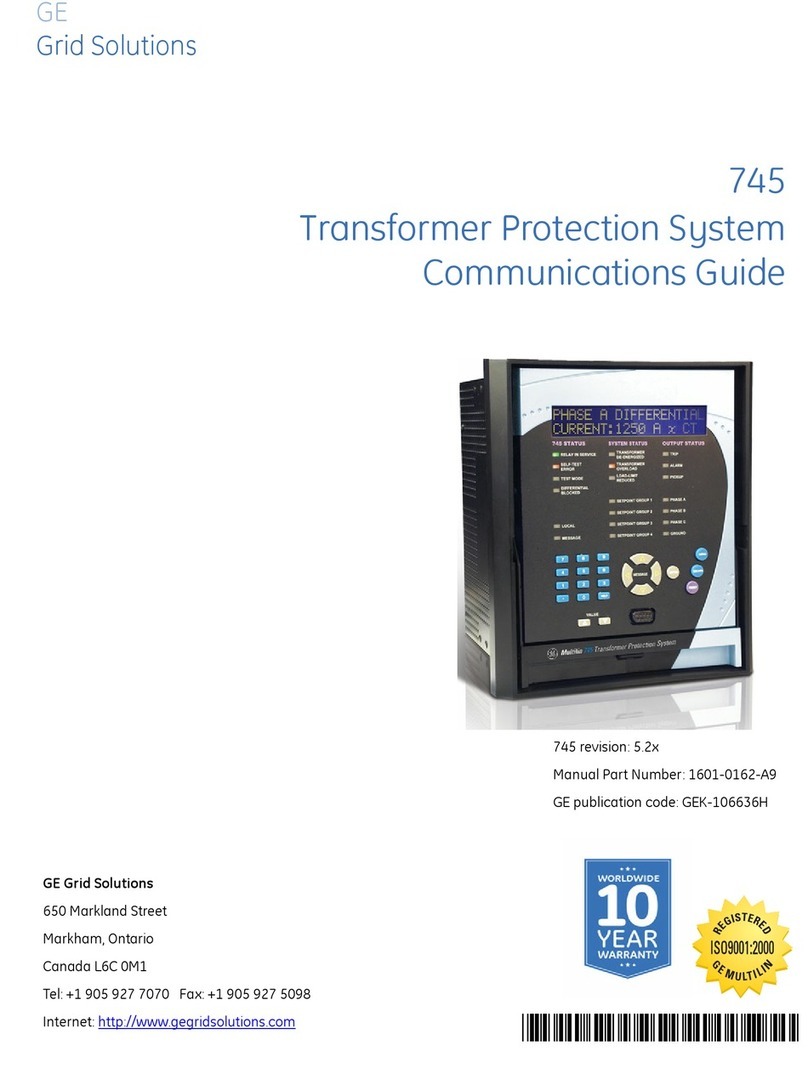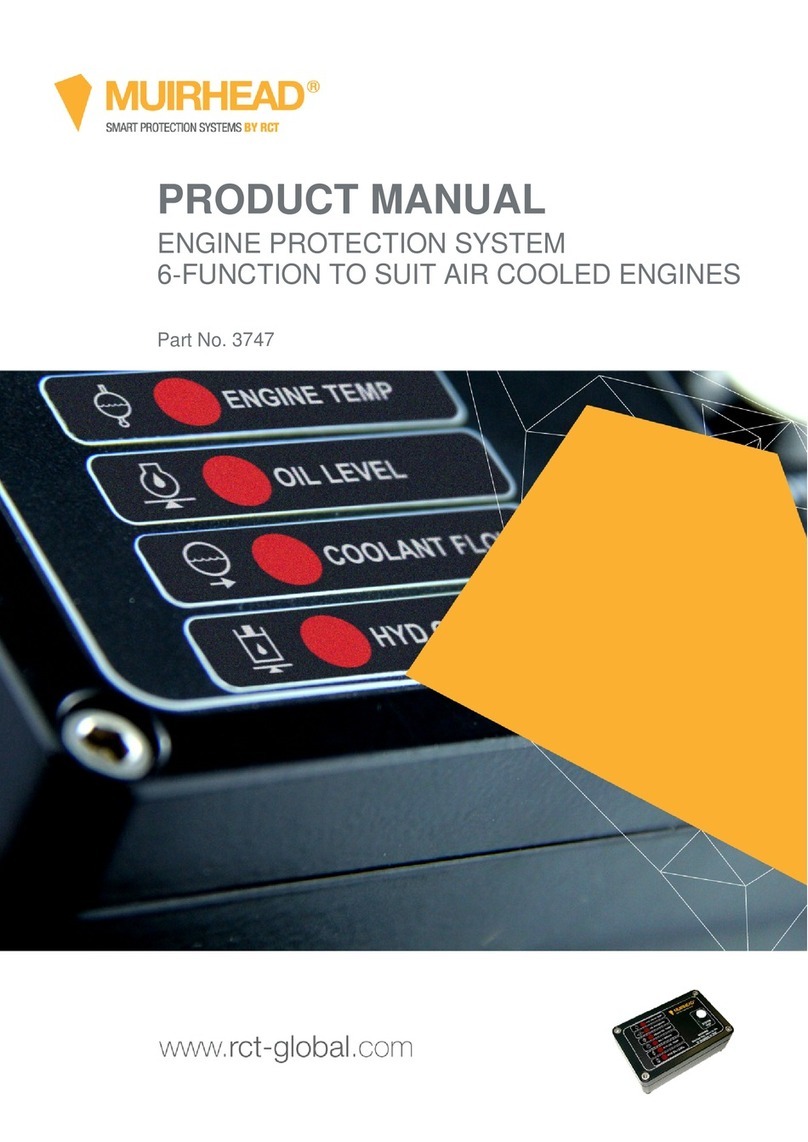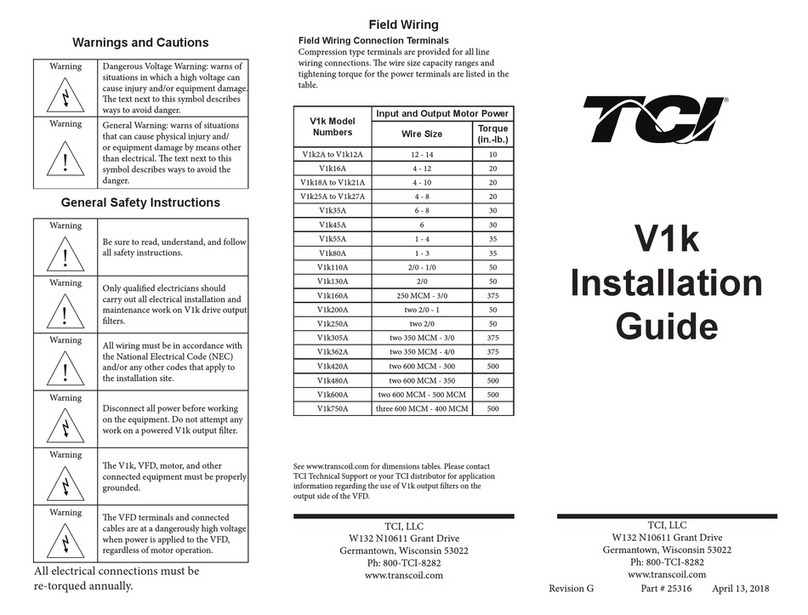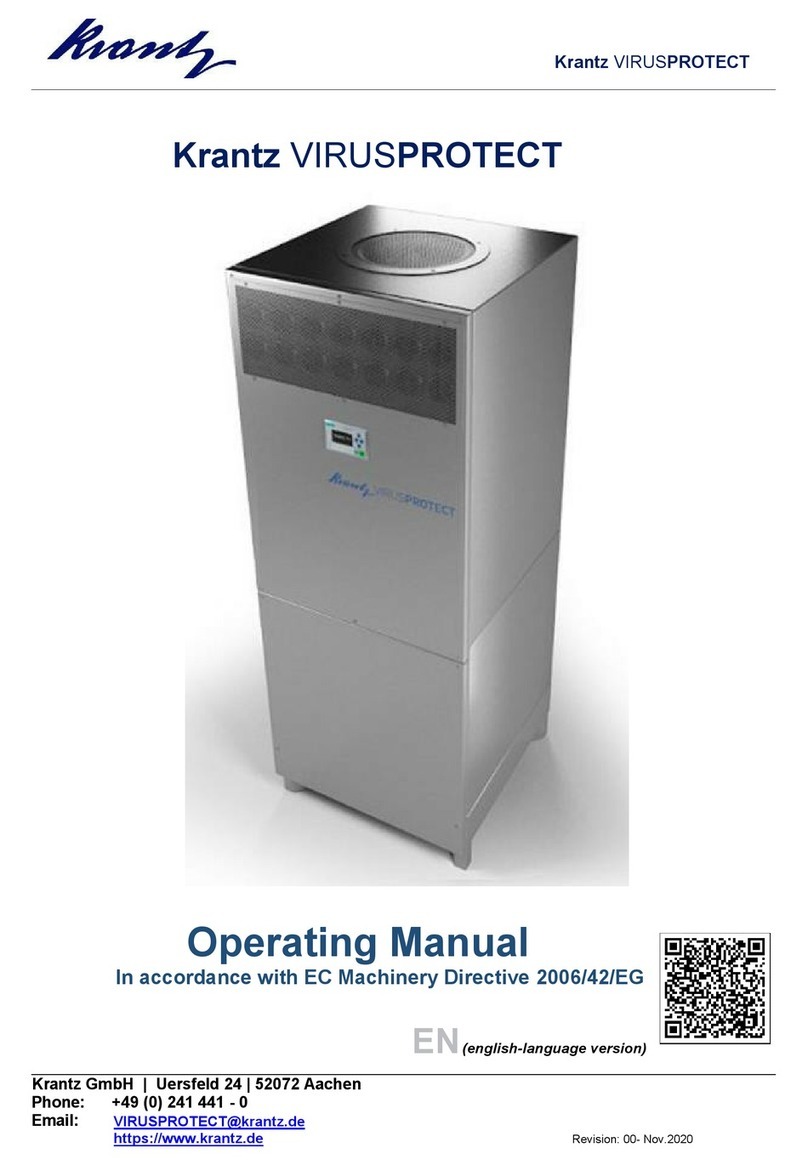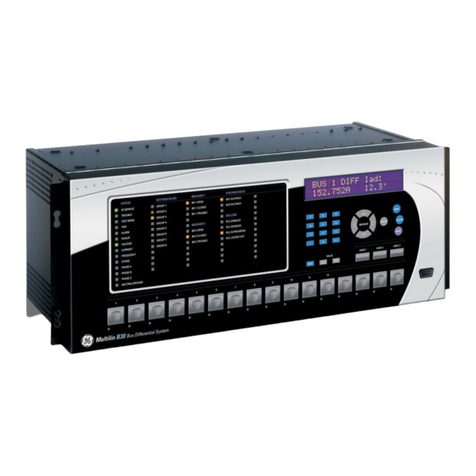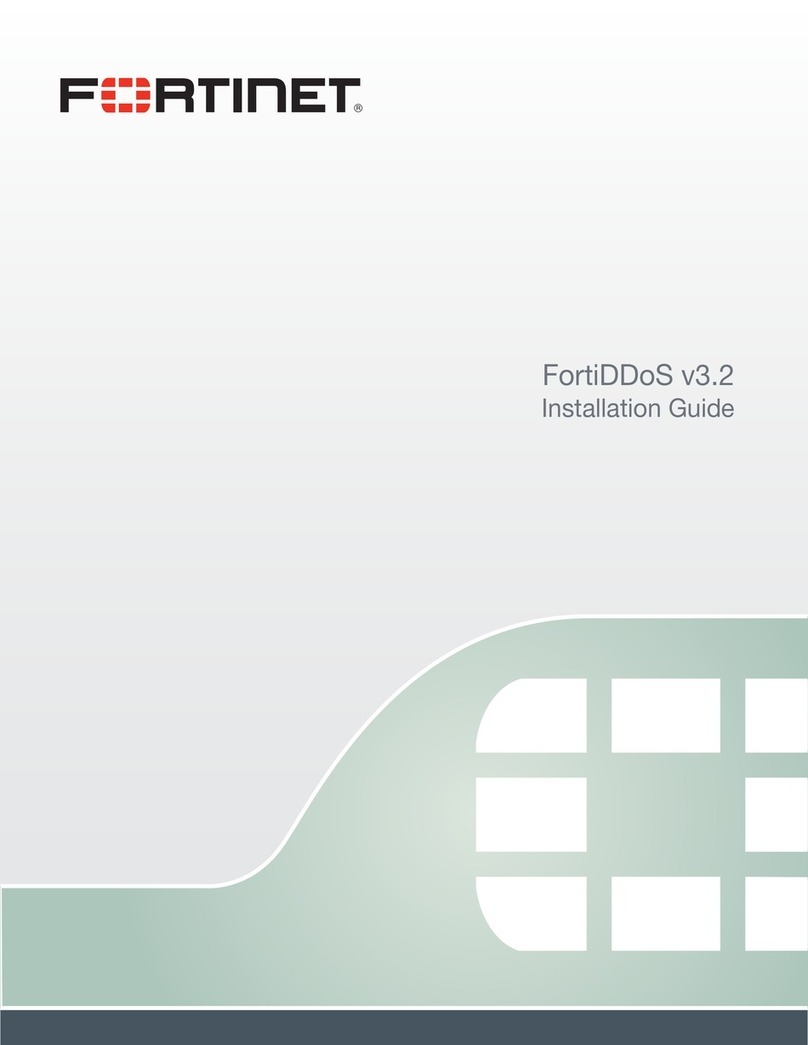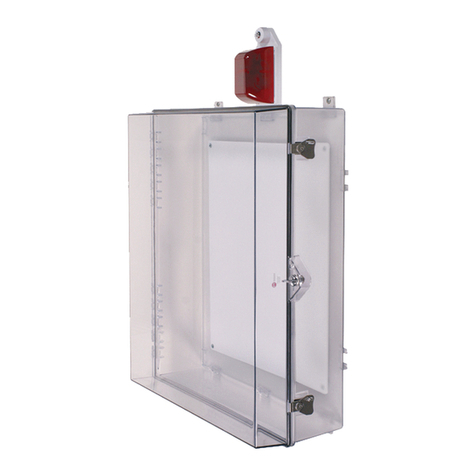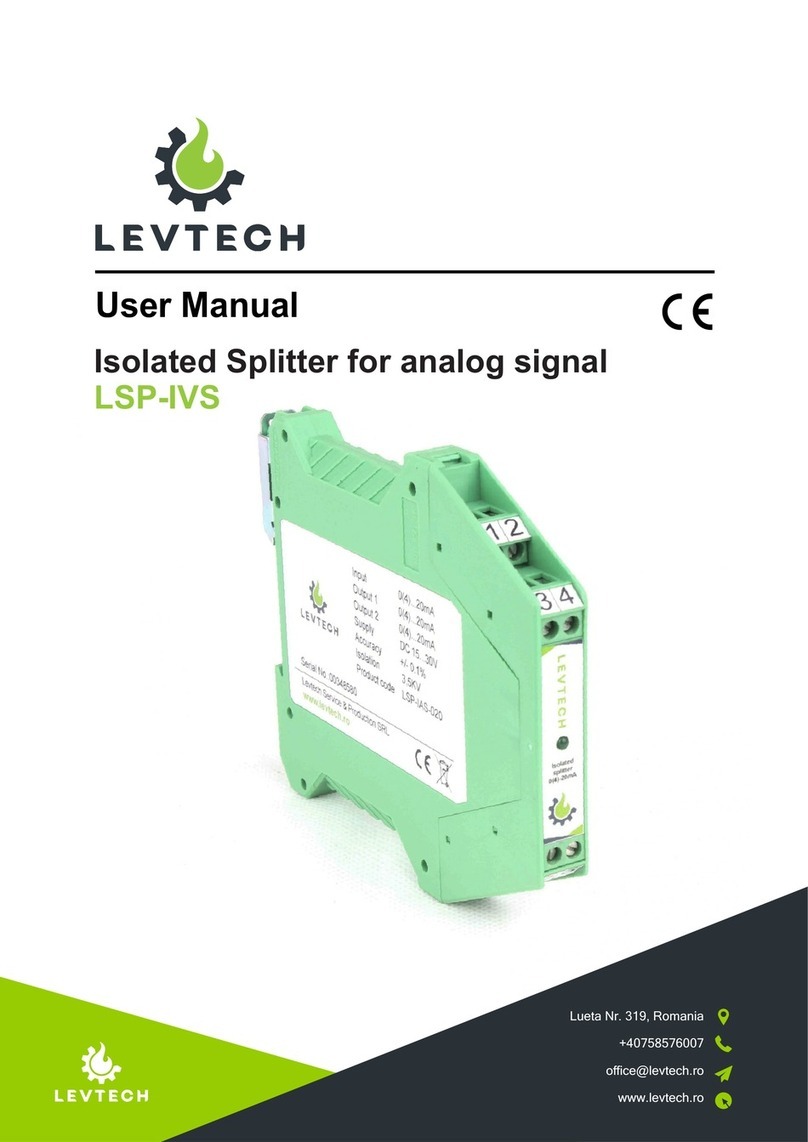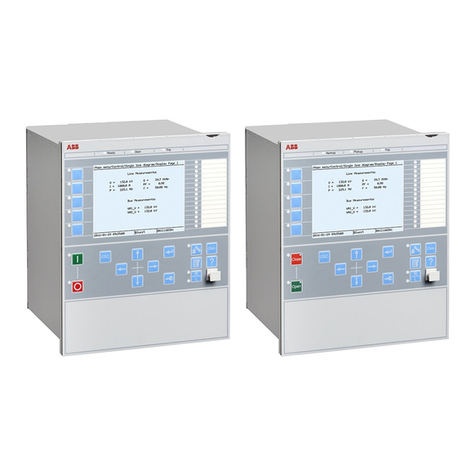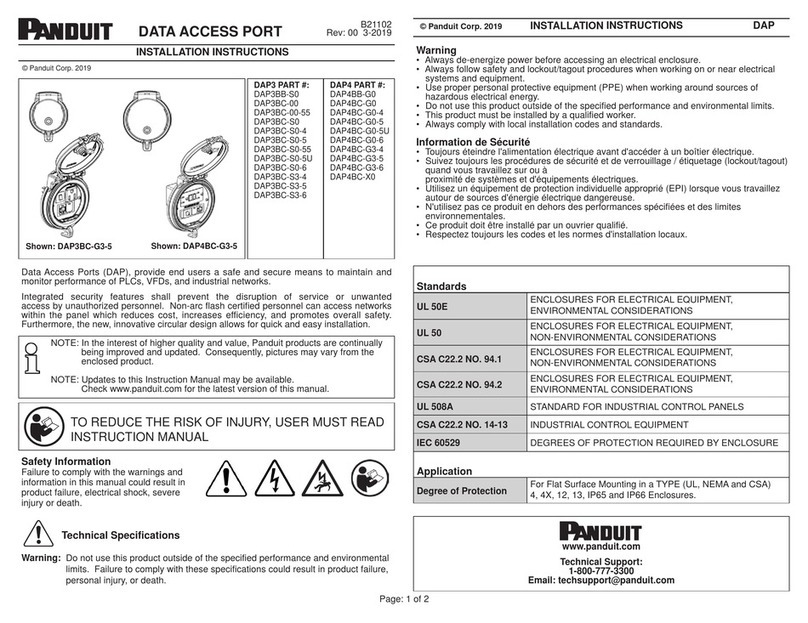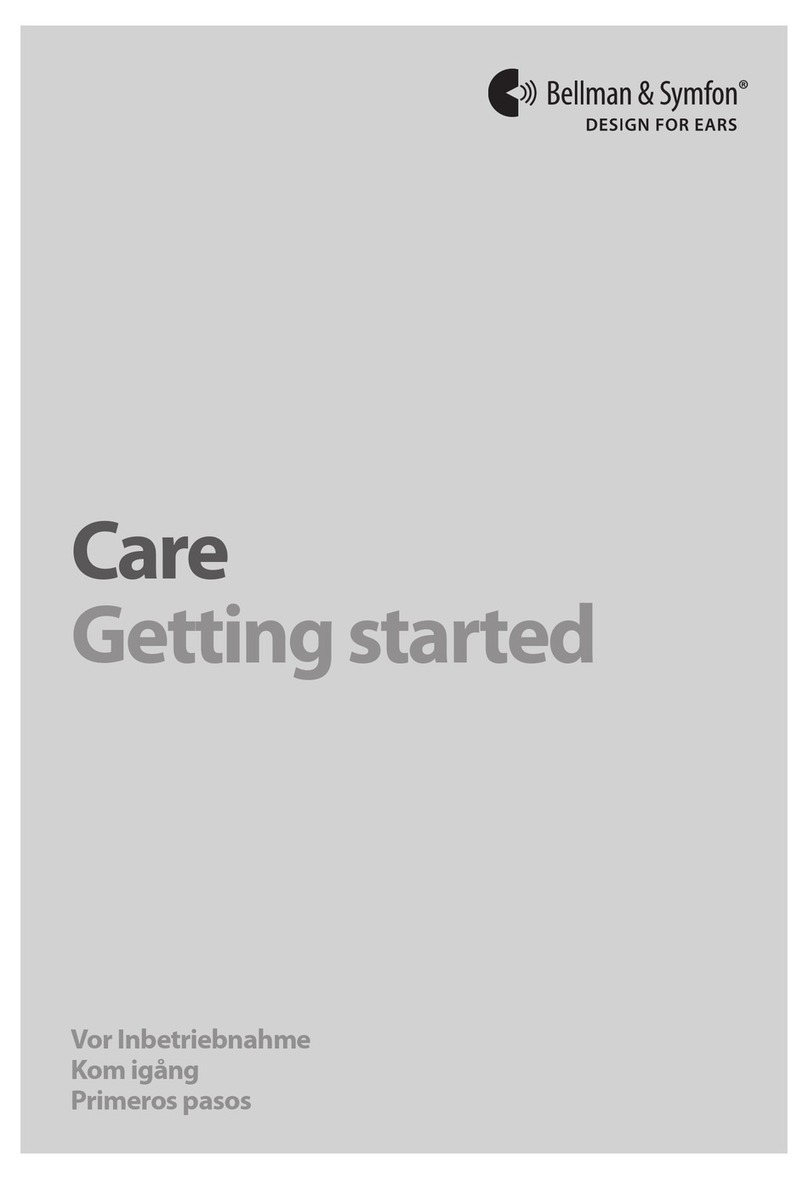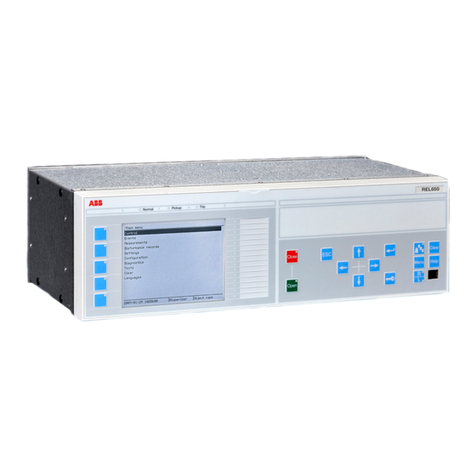I-Gard IPC DSP OHMNI User manual

Instruction Manual C-409
HIGH RESISTANCE
GROUNDING SYSTEM
DSP OHMNI
DSP OHMNI
the power to protect

HIGH RESISTANCE GROUNDING
IMPORTANT
Each DSP module is carefully inspected before packed in a specially designed carton. The unit should be examined
immediately upon receipt. If damage or indication of rough handling is apparent, a claim should be filed without
delay with the transport company. I-Gard should be notified promptly if replacements for damaged goods are
necessary. If units received are not to be installed immediately they should be stored in their original containers in an
area free of dust and moisture.
DSP Second Fault Protection – unnecessary outages of electrical power in continuous process industries or
in critical systems applications such as hospitals, air traffic control towers etc cannot be tolerated and this has
increased the usage of high resistance grounding systems.
The new DSP Ohmni System is designed to provide an alarm, but not trip when one ground fault occurs in the
system thus retaining system continuity. If a second fault develops on the system, before an existing fault has
been cleared, then the potential for serious damage results.

TABLE OF CONTENTS
1 Introduction 3
2Application 4
3Installation 5
4Wiring 6
5Display 10
6Setup 11
7Operation 18
8Alarm Indications 20
9 Self-Test 22
10 Events 23
11 Maintenance and Testing 24
12 Service 25
13 Communications 25
14 Specifications 31
15 Outline Dimensions 33
16 Additional Information 36
17 Instruction Manuals ibc
TABLES
Table 3.1 System Module Requirements 5
Table 3.2 Standard Ribbon Cables 5
Table 6.1 Pulsing Frequency Selection 17
Table 13.1 MODBUS RTU Standard 8 Byte Holding Register Read Function (03) 26
Table 13.2 Returned Information Structure for Holding Register Request 26
Table 13.3 Request to Write to Set a Bit on a Register (Modbus Force Coil) 26
Table 13.4 Returned Information from Dsp Following a Force Bit Request 27
Table 13.5 Feeder Module Ground Current Addresses 28
Table 13.6 Feeder Module Status Addresses 29
Table 13.7 Feeder Module Priority Addresses 30
Table 13.8 System Function Registers 31

I-GARD DSP-OHMNI Instruction Manual
2
TABLE OF FIGURES
Figure 4.1 a) Typical One-Line Installation - Unit Substation b) System Module DSP-DSM Wiring 7
Figure 4.1 c) Power Supply DSP-DPS wiring 7
Figure 4.2 Preferred Feeder Module DSP-DFM Wiring 8
Figure 4.3 Alternative Sensor Wiring 8
Figure 4.4 Typical 4-wire Communications Connection 9
Figure 4.5 Alternative two-wire connection for RS-485 10
Figure 5.1 Home Screen 10
Figure 5.2 Alarm Screen 10
Figure 6.1 Communications Set-up 11
Figure 6.2 Communications Set-up 11
Figure 6.3 Grounding Resistor Set-up 12
Figure 6.4 Feeder Module Set-up 12
Figure 6.5 I/D Check indication 13
Figure 6.6 Feeder Module Set-up 14
Figure 6.7 a) Feeder Module Successful b) Set-up Not Successful 14
Figure 6.8 a) DSP-DM allows further Feeder Module set-up b) If previous set-up had not been successful 14
Figure 6.9 Pulse Set-up Request 15
Figure 6.10 Pulse Mode Set-up 15
Figure 6.11 Typical Examples of Pulse Circuit Connection 16
Figure 6.12 Alarm relay Setup 17
Figure 6.13 Alarm relay Options 17
Figure 6.14 Save Screen 18
Figure 6.15 Self-Test Prompt 18
Figure 7.1 Normal Home Screen 18
Figure 7.2 System leakage current lG19
Figure 7.3 Feeder Current IGf 19
Figure 7.4 Trip Defeated 19
Figure 7.5 Pulse Control 20
Figure 7.6 New Home screen indicates Pulsing ON 20
Figure 8.1 Alarm Screen 21
Figure 8.2 Bus Fault 22
Figure 9.1 System-Test Prompt 22
Figure 9.2 Prompt for Feeder Test 22
Figure 9.3 Feeder Module Test 23
Figure 9.4 Test Result 23
Figure 10.1 Event Notification 23
Figure 10.2 Momentary Feeder Fault Example 23
Figure 15.1 DIN Rail Mounted Modules 33
Figure 15.2 DSP-DM Display Module with cut-out detail 34
Figure 15.3 DSP-DPS Power Supply Connections 35
Figure 15.4 DSP-DSM System Module Connection 35
Figure 15.5 DSP-DFM Feeder Module Connection 35
Figure 15.6 DSP-DM Display Module Connections 36

DSP-OHMNI Instruction Manual I-GARD
3
1INTRODUCTION
High-Resistance-Grounding is becoming more prevalent in industrial and commercial electrical power
systems. As the need for reliable and stable power increases the inconvenience of unwanted downtime
in processing, robotics and data service also become more critical and costly.
Single Ground Faults in motors and equipment are common and will cause interruption of service
in Solidly Grounded systems. HRG prevents this event from happening by limiting the fault current to
a sustainable level for an indefinite time.
The DSP system is designed to detect the event of a single fault and signal an alarm condition and point
to the affected branch or feeder. Thus maintenance can be immediately alerted to the problem and an
operator dispatched to locate the fault to isolate it promptly. The DSP system can assist in locating the
fault with a pulsing fault location circuit that modulates the current in the fault. This allows the operator to
identify which branch circuit is carrying fault current using a portable clamp-on current probe connected
to an ordinary Multi-meter.
The DSP system consists of a number of modules that are mounted on a 35mm DIN rail typically located in
a control compartment of switchgear. The modules are connected together through 20-conductor
standard ribbon cable. A panel-mounted Display module provides a human interface to the system
and communications to a RS-485 network allows set-up and control.
There are four DSP modules as follows:
DSP-DM Display Module
DSP-DPS Power Supply
DSP-DSM System Module
DSP-DFM Feeder Module
The Display Module is a panel-mounted enclosure designed for flush mounting in a door. It is connected by
a ribbon cable to the Power Supply unit. The DSP-DM indicates faulted phase, total
system leakage current, feeder branch current level and provides other information such as priority
settings and Resistor setting etc. It is used to set-up the system and provide manual control of the
pulse location system.
The POWER Supply unit DSP-DPS is a DIN rail-mounted modular unit constructed with an ABS enclosure
and provides +5V, +12V and -12V regulated supplies to all of the modules through the front ribbon cables. It
is capable of operation with a wide range of voltage supplies from 100V to 240V ac without selection of any
jumpers or switches. DC voltage can also be used from 125V to 250V DC.
The System Module monitors the system line-to-ground voltages through a standard I-Gard Corp. DDR2
voltage dividing resistor unit. It determines if there is voltage unbalance in the system and the level
of ground fault current in the grounding resistor, without any connection to the Resistor.

I-GARD DSP-OHMNI Instruction Manual
4
The Feeder Modules measure the fault current level in the branch circuits that are protected. This module
uses standard I-Gard current sensors Type T2A, T3A, T6A and T9A. It is equipped with a form C 10A
output Relay that can be used for breaker control. The DSP-DFM detects two fault levels. Firstly it detects
the single fault, which creates a System Alarm condition, and secondly through a priority level system it
provides breaker control to disconnect the least important circuit breaker.
Communications is provided by a 4-wire RS-485 network connection from a jack located at the rear of the
DSP-DM Display module. The communications protocol supported is MODBUS RTU, which is a master/
slave system with selectable baud rates from 4800 to 19200. The DSP supports the MODBUS function Read
Holding Registers only, without exception support. Additionally it will support remote RESET using the Force
Coil function.
2APPLICATION
The DSP system is used in conjunction with I-Gard, Alarm Resistor Unit Type DDR2. The DDR2 matches
the DSP-DSM input circuits to the system voltage and is available in 4 types as follows:
Type System Voltage
DDR2-1 120V*
DDR2-2 240V
DDR2-4 480V
DDR2-6 600V
* Also used with potential transformers up to 13.8KV
The DDR2 provides output voltages VAG, VBG, VCG that are proportional to the phase to ground voltage and
also voltage VNG that is proportional to the neutral resistor voltage. ( i.e. Total leakage/fault current of the
system)
On large systems provision is usually made to ground the system using a current-limiting resistance
(I-Gard Type OHMNI-PM or NGR). On ungrounded systems there is always leakage capacitance to ground
from each line. Re-striking ground faults may cause an excessive build up of line to ground voltage due to
this capacitance. It may be stabilized with the addition of a grounding resistance, thus preventing costly
breakdown of insulation.
The Type OHMNI-PM is connected between ground and the star point of the transformer on Wye systems.
On Delta systems an artificial neutral device (I-Gard Type DDAI) is required to provide a star point. Both
OHMNI-PM and DDAI devices are selected for appropriate current ‘let-through’,i.e.: The current, which will
flow to ground, if there is a direct short from line to ground (on any one phase).
NOTE: A good Rule-of-Thumb for Resistor current selection is 1 ampere per 2000KVA, if no surge capacitors are on the system,
and 1 ampere per 1000KVA with surge capacitors. For further information please refer to www.i-gard.com/appguides.htm

DSP-OHMNI Instruction Manual I-GARD
5
DDAI and OHMNI-PM devices are available for continuous currents of 1 ampere to 10 amperes for
most systems. For further information regarding the use of these devices refer to:
Instruction Manual Type DDAI Artificial Neutrals C-430EM
Instruction Manual Type DDR2 Alarm Resistor Units C-440EM
Instruction Manual Type OHMNI-PM Neutral Grounding Resistors C-450EM
3INSTALLATION
A typical installation will include for each power source (transformer/generator) 1 DSP-DM, 1 DSP-DPS,
1 DSP-DSM and a number of DSP-DFM Feeder Modules as required with 1 for each branch protected.
Additionally there will be a DSP-PM pulsing resistor to ground the system. A voltage-sensing resistor DDR2
is required for the DSP-DSM input, as well as one current sensor for each DSP-DFM for current detection.
See Table 3.1 for typical requirements.
TABLE 3.1 SYSTEM MODULE REQUIREMENTS
Catalog Number Description No Required/System
DSP-DM Display Module 1
DSP-DPS Power Supply 1
DSP-DSM System Voltage Module 1
DSP-DFM Feeder Module As required 1/ Circuit
OHMNI-PM Pulse Equipped Resistor 1
DDR2 Voltage Sensing Resistor 1
DDAI Artificial Neutral Required only for delta system
T Toroidal Current Sensor 1/Feeder Module
TABLE 3.2. STANDARD RIBBON CABLES
Length Function Catalog Number
365cm (12ft) DSP-DM to DSP-DPS DRC-365
150cm (5ft) DSP-DM to DSP-DPS DRC-150
5cm (2 in.) Module to Module connection RC-3
30cm (12 in.) Module to Module connection RC-30
DSP modules are mounted on a 35mm DIN Rail generally located at the rear wall of a switchgear
compartment. They should be mounted side by side and connected with 20-conductor ribbon cable in a
daisy chain configuration. This applies to the DSP-DPS, DSP-DSM and DSP-DFM modules only.

I-GARD DSP-OHMNI Instruction Manual
6
DSP (Outline Dimensions). Care should be taken not to over tighten the 8-32 nuts used to retain the
DSP-DM
It will be necessary to provide a reliable power source (which is not interrupted by operation of the DSP
output contacts) for control power. The supply should be 100-240 V AC/DC. The control supply must be
fused by 1 Ampere fuses as shown in Fig. 4.1 a (Connection Diagram). Ideally the alarm, warning bell should
be connected to a separate control supply from the DSP (see para. 8.3.1).
4WIRING
No.14 or No.16 switchboard wire is used for all current sensor, control and DDR2 connections, which need
not be shielded. 4-wire shielded cable should be used for the serial communications, however. A typical
wiring schematic is shown in Figure 4.1a.
Sensor wiring is not generally limited by length and may be up to a kilometer without degradation of
performance, since the sensor is a current source. Sensor wiring should be run in separate conduit from
Power wiring. The recommended sensor wiring connections are shown in Figure 4.2. Two wires should
be run from each sensor X1 and X2 as indicated to prevent cross coupling between Modules. If existing
wiring does not allow this connection because of common connection at X2 as has been common in some
installations, then the G terminals of the DSP-DFM modules should be connected as shown in Figure 4.3.
Ribbon cables are available in different lengths as shown in Table 3.2. For other lengths contact
I-Gard. The DRC-cable from the DSP-DM to the DSP-DPS, apart from being different in length, also differs
in the orientation of the connector. This allows the cable to be run easily from the DSP-DM towards the
DSP-DPS power supply. The RC-cables are used for Module to Module connections and are short in
length. Note the orientation of the plug as marked on the DSP-DM display module. If a second row of
modules is installed on another DIN rail,the last module on the right can be connected to the last module
on the right on the second row using the RC-30 cable. Either slot can be used on the DSP-DFM feeder
modules for connection.

DSP-OHMNI Instruction Manual I-GARD
7
13 15 17
GCA
TO DDR2-
RESISTOR
BN
14 16
Figure 4.1b System Module DSP-DSM Wiring
27 29 31 33 34 36 38 40 41
NC COM NO + - VAC VAC G G
100-240V
ALARM
RELAY TO
HORN
12V DC
PULSE
OUT
SYSTEM
GROUND
CONTROL
1A1A
Figure 4.1c Power Supply DSP-DPS wiring
DDR2
25VA CPT
120V
OHMNI-PM NGR
MAIN BUS
HORN
1A
PULSE SIGNAL
DSP-DSM
ZSCS
BREAKER
TRIP SIGNAL
ALARM
CONTACTS
ABCNG
AB NGC
POWER
AC/DC
DSP-
DFM
LOADS
DSP-
DFM
DSP-DPS
DSP-DM
RS-485 TO NETWORK
DSP-
DFM
DSP-
DFM
1A
1A
N
G
20 COND
RIBBON
Figure 4.1a Typical One-Line Installation - Unit Substation

I-GARD DSP-OHMNI Instruction Manual
8
Figure 4.3 Alternative Sensor Wiring
Shunt Trip
Supply
Sensor 1 Sensor 2 Sensor 3 Sensor 4
To
DSP-DSM
G S NO NC COM
678910
DSP-DFM
G S NO NC COM
678910
DSP-DFM
G S NO NC COM
678910
DSP-DFM
G S NO NC COM
678910
DSP-DFM
Figure 4.2 Preferred Feeder Module DSP-DFM Wiring
NOTE: For Main-Tie-Main systems and multiple sources with tie breakers the priority buses can be joined together with the use
of I-Gard devices DSP-CAS and DSP-CA Modules. The DSP-CA module converts ribbon cable to an8-conductor shielded cable
for this purpose. The DSP-CAS does the same thing except that it includes an electronic switch to make or break the connections
when the tie breakers are closed or open. This eliminates the use of 8-pole contactor arrangements of previous systems. The two
modules are DIN rail mounted similar to the other DSP modules in 70mm wide housing. See information on DSP-CA(S) or manual
C-414EM for typical wiring.
Shunt Trip
Supply
Sensor 1 Sensor 2 Sensor 3 Sensor 4
To
DSP-DSM
X1
X2
X1
X2
X1
X2
X1
X2
G S NO NC COM
678910
DSP-DFM
G S NO NC COM
678910
DSP-DFM
G S NO NC COM
678910
DSP-DFM
G S NO NC COM
678910
DSP-DFM

DSP-OHMNI Instruction Manual I-GARD
9
The RS-485 cable shield should be grounded at the ground terminal provided on the 5–pin jack as shown
in Figure 4.4, which shows a typical installation with a local computer and LAN.
Communications may be supported as a node in an existing MODBUS network or may be connected
through a standard RS-485 to RS-232 converter to a PC with supporting software.
The Alarm contacts are available at the DSP-DPS as a Form C type and should be connected to operate
a horn or other means to alert an operator to the fact that a fault has occurred on the HRG system. The
contacts are rated at 10A, 240VAC Resistive.
Figure 4.4 Typical 4-wire Communications Connection
Communications wiring may be 2-wire or 4-wire but must use shielded cable with low capacitance. Wire
lengths up to 2000 metres can generally be used without the need for termination resistors.
Figures 4.4 and 4.5 show typical RS-485 arrangements with a RS-485/RS-232 converter and a host PC
connected to a LAN.
DSP-DM
(01)
DSP-DM
(nn)
RS-232
COM Port
Computer
Host
Other 485 Devices
Network
TCP/IP

I-GARD DSP-OHMNI Instruction Manual
10
Figure 4.5 Alternative two-wire connection for RS-485
For Fault location the DSP system is equipped with Pulse modulation for the ground current to identify the
fault more readily. Pulse current is provided at the DSP-DPS (+) and (-) terminals, which may be directly
connected to the Pulse Relay in the DSP-PM grounding Resistor. It is important to observe the polarity of
the connection. This 12V wiring need not be shielded but should be 14 AWG switchboard wire for durability.
5DISPLAY
Following successful installation of the DSP system and connection of the control voltage,the DSP-DM
display module should indicate a Green NORMAL light and the screen should show the following message.
I-GARD
HRG SYSTEM OK
Figure 5.1 Home Screen
If the following screen appears and the local Alarm sounds, then most likely the DDR2 resistor is not
energized or connected.
3 PHASES LOST
CHECK DDR2 FUSE
Figure 5.2 Alarm Screen
DSP-DM
(01)
DSP-DM
(nn)
RS-485 to RS232
Converter
RS-232
COM Port
Computer
Host
Other 485 Devices
Network
TCP/IP
Tx+Tx-Rx+Rx-
Tx+ Tx-Rx+Rx- G
G
Tx+Tx-Rx+Rx- G

DSP-OHMNI Instruction Manual I-GARD
11
Most of the screen navigation is done with the ukey on the faceplate label of the DSP-DM. Pressing this
key once will switch screens to the System Status screen which shows the total system leakage IG. This
is derived from voltage measurement of the system voltages and is proportional to the current through the
grounding resistor of the system. It should appear as in Figure 5.1. This is the Home Screen, Screen1, which
is the NORMAL starting screen after RESET is pressed. Various messages may modify this screen following
an event such as a fault, loss of fuse, or during pulsing to provide some diagnostic information.
6SETUP
On a new installation some simple set-up is required with at least Maximum System Current (NGR set-up)
and Feeder Modules being set prior to use of the equipment. Optional settings are Communications and
Pulse Control.
6.1 Communications
To enter the Set-Up Mode press SETUP when the Home Screen or Alarm Screen is showing (SETUP
will not enter from any other screens). If confused at any point, press RESET and the Home Screen (or
Alarm Screen - if a fault has occurred) will be shown. Figure 6.1 shows the first set-up screen that will be
encountered – COMMS set-up mode.
SETUP COMMS? Y/N
Figure 6.1 Communications Set-up
If you are not using the RS-485 connection, then press ENTER to skip to the next set-up, otherwise press
tto move the flashing cursor to select Y (for Yes) and press ENTER. The communications screen will
appear similar to Figure 6.2. The screen will show the set-up presently in use, or the default as shown.
MODBUS 1/D 01
BAUD RATE 4800
Figure 6.2 Communications Set-up
The DSP system must be identified by a number from 01 to 32, to distinguish between it and other
MODBUS devices that may be connected on the same RS-485 network. If only one device is used then it
will typically be set to 01, which is the default value. (Ensure that no other device has the same I/D setting
on the RS-485 network or data will not be valid). To change the number, use the pq arrows to increase/
decrease the digit under the flashing cursor and ut to change digits.

I-GARD DSP-OHMNI Instruction Manual
12
When a desired number has been entered press ENTER to change the Baud Rate setting if required. The
present rate will be shown. Press pto select another setting. Only three baud rates are provided (4800,
9600 and 19.2K).
Keep pressing the pbutton and the selection will simply scroll through the three settings until ENTER is
pressed to finalize the Communications Set-up and show the screen of Figure 6.3. Select Y to enter this
set-up or ENTER to move to Feeder Module Set-up.
6.2 NGR
a)
SETUP NGR? Y/N
b)
IG CURRENT A 05
SET TO NGR 1-16A
Figure 6.3 Grounding Resistor Set-up
The next screen following Communications is the Grounding Resistor Setting. This setting must be set
according to the current limiting value of the grounding Resistor of the HRG system. The default value is
1A. To change the number, use the pq arrows to increase/decrease the digit under the flashing cursor
and ut to change digits.
The final value must be between 01 and 16 for 1-16A range. Press ENTER when completed.
CAUTION! THE SYSTEM WILL ALLOW YOU TO SELECT INVALID NUMBERS OUT OF RANGE, WITHOUT WARNING,
BUT THE RESULTS WILL BE INDETERMINATE.
6.3 Feeder Module SETUP FM? Y/N
FEEDER SEL 01
TRIP ON PRIOR 00
Figure 6.4 Feeder Module Set-up
Following the OHMNI-PM set-up the display prompts for Feeder Module Set-up. Select Y to enter the
Feeder Module setup screen as shown in Figure 6.4 (b).
After installation of Feeder Modules they must be given identification numbers from 01 to 50 (maximum)
so that the Display unit can determine which module it is talking to. Each module must have a different
number. To change the number, use the pq arrows to increase/decrease the digit under the flashing
cursor and ut to change digits.

DSP-OHMNI Instruction Manual I-GARD
13
The Display module is the master module and is constantly sending requests for data from each feeder
module from 1 to 50. The Feeder Modules compare the request I/D with their own I/D to decide whether
or not they are being asked for data. If the I/D is the same then that Feeder Module replies with Current,
Priority and Status information to the master Display Module. Therefore it is very important that there
are not modules in the chain with the same I/D. The Feeder Select program checks for duplicate I/D
when ENTER is pressed following an entry of FEEDER SEL xx. If an existing I/D is detected, the screen will
indicate as in Figure 6.5.
I/D IN USE 01
TRIP ON PRIOR 00
Figure 6.5 I/D Check indication
In this case the user must enter a different I/D number before proceeding further. The user is allowed
another chance to enter a valid I/D number before the cursor moves to TRIP ON/OFF selection. This
permits the TRIP and Priority of previously set modules to be changed while retaining the same I/D number.
CAUTION! IT IS ENTIRELY POSSIBLE FOR THE USER TO ENTER A NUMBER OUTSIDE THE RANGE 01 TO 50 AND
THE SYSTEM WILL ACCEPT IT WITHOUT WARNING, DATA WILL NOT BE COLLECTED FROM SUCH MODULES,
ALTHOUGH THEY WILL CONTINUE TO PROVIDE FAULT PROTECTION.
Typically, the numbers will be in the sequence 1,2,3,4…. but they can be in any order physically. The
Display Module does not care. The identification number, however, must be known for each feeder circuit
since the Display does not support the use of Text Labelling to identify circuits. Note: This can be done
with user-provided software from the RS-485 network if required or by use of the DSP.net server package
downloadable from the I-Gard web site. See communications section.
Press ENTER to select the Ident Number. The cursor then drops to TRIP ON setting which is the normal
setting. To disable the TRIP function of the Feeder Module press tarrow in which case no priority is
required to be set and the Screen of Figure 6.6 is presented.
If the TRIP feature is to be retained (normal setting) pressing ENTER will then allow the user to set the priority
of the selected Feeder I/D. To change the number, use the pq arrows to increase/decrease the digit under
the flashing cursor and ut to change digits. The range of priority numbers is from 00 to 15 with 0 being a
lower priority than 15. In the case of Priority numbers it is OK to use the same number more than once unlike
the I/D numbers, so that unimportant circuits can all be set to 00, for example.

I-GARD DSP-OHMNI Instruction Manual
14
When the desired priority for a given I/D number has been selected, press ENTER. You will then be
prompted with the screen of Figure 6.6
PUSH FM BUTTON
AND THEN ENTER
Figure 6.6 Feeder Module Set-up
At this point select the DSP-FM module that is to have the I/D that was set-up, and press the TEST button
on that module. The red FAULT light will turn on to indicate the received I/D signal.
Press ENTER to complete the process. The DSP-DM will display either of the following messages
depending on whether or not the setup was successful.
FM ACCEPTED
CONTINUE ®
a) Feeder Module Successful
FM NOT ACCEPTED
CONTINUE ®
b) Set-up Not Successful
Figure 6.7
Press uto exit the screen and the DSP-DM will allow the user to set-up more Feeder Modules with screen
10 a) and b)
FM ACCEPTED
ANOTHER? Y/N
a) DSP-DM allows further Feeder Module set-up
FM NOT ACCEPTED
ANOTHER? Y/N
b) If previous set-up had not been successful
Figure 6.8

DSP-OHMNI Instruction Manual I-GARD
15
If more Feeder Modules need to be set-up then select Y and ENTER to repeat, or if not select N and ENTER
to exit the Feeder Module Set-up and enter the PULSE Set-up. The Pulse set-up screen allows the pulsing
mode for fault location to be changed for different frequencies and mode of operation. The screen of Figure
6.9 is shown.
6.4 Pulsing SETUP PULSE? Y/N
Figure 6.9 Pulse Set-up Request
PULSE INVRT? OFF
FREQ 0 LOCK? OFF
Figure 6.10 Pulse Mode Set-up
Select Y to enter the Pulse Set-up Screen which looks like Figure 6.10 which will show the existing set-up
of the PULSE module. The pulsing information is stored in the DSP-DSM, which must be installed during
setup. Press tto toggle the setting ON or OFF as required.
6.4.1 Invert / NDR MAL
The output from the DSP-DPS module is connected to a solid state relay. Normally (non Inverted operation)
the output from the ‘+’ and ‘-‘ terminals of the DSP-DPS module is zero prior to any pulsing operation,
and the relay is OFF. If Inverted mode is selected, then this voltage is 12V dc. And the relay is, therefore,
energized continuously. The choice of NORMAL or INVERTED operation depends on how the Grounding
Resistor current is connected. If the Grounding resistor consists of two series or two parallel resistors (one
main resistor and one pulse resistor) with the pulse resistor to be switched in and out by a solid state relay
then the following two options exist.
a) Pulse Up current
Pulsing upwards means to increase current from IGmax 5A to IGmax 10A, for example. In this case the
pulse resistor is normally OFF and the INVRT OFF would be selected. Pulsing would then change the
current to a higher level from 5A to 10A alternating when a 100% fault exists.
b) Pulse Down current
Pulsing downwards means to reduce the current from IGmax 5A to IGmax 2.5A, for example. In this case
the pulse resistor will be Normally ON and thus the INVRT ON mode would have to be selected. This
will mean that the solid state relay will be ON when the system is normal (no fault) and will open when
pulsing is started thus reducing current.
See Diagram 6.11 for examples of both series and parallel connected resistor arrangements.
NOTE: the INVRTed mode is the mode used with the standard OHMNI-PM resistors as supplied by I-GARD.

I-GARD DSP-OHMNI Instruction Manual
16
Figure 6.11 Typical Examples of Pulse Circuit Connection
X
0
X
0
X
0
X
0
X
0
R
G
R
G
R
G
R
G
R
P
R
P
R
P
R
P
5A
5A 2.5A 2.5A 5A
5
10
0
2.5
5
0
5
0
INVRT
OFF
INVRT
ON
INVRT
ON
INVRT
ON
INVRT
OFF
5
10
0
2.5
5
0
a) Pulse UP Parallel
Resistors
b) Pulse Down Parallel
Resistors
c) Single Resistor
a) Pulse UP Parallel
Resistors
a) Pulse UP Parallel
Resistors
RG
+
-
+
-
+
-
+
-
+
-

DSP-OHMNI Instruction Manual I-GARD
17
6.4.2 Pulsing Frequency
Press ENTER when the selection is chosen. The cursor will then move to the FREQuency position.
Press pq to select a pulse frequency from 0 to 9 with frequency increasing with the number selected.
It is not important to know exactly the frequency selected, however, Table 6.1. Indicates the frequency
for each setting.
TABLE 6.1 PULSING FREQUENCY SELECTION
Select 0 123456789
Freq Hz. 1.0 1.25 1.50 1.75 .2.00 .2.25 2.50 2.75 3.00 3.25
6.4.3 Interlock
Press ENTER after a value has been selected and the cursor moves to the interLOCK position. The
interlock prevents pulsing from occurring when there is no fault on the system. Press tto toggle ON or
OFF and then ENTER to complete the Pulse set-up.
6.5 Alarm Relay
For the next Setup the user will then be presented with the option to change the operation of the MUTE
function. The MUTE button normally disables the Alarm Relay and the local Beeper Alarm when pressed
to following a fault. However, the designer might use the Alarm Relay for some other function, for example
another contactor or cooling fan operation of the grounding resistors. In this case it is undesirable to MUTE
the relay. For this reason the operator may choose to disallow the MUTE button to change the state of
the Alarm Relay. The Screen of Figure 6.12 is presented.
ALARM RELAY Y/N
Figure 6.12 Alarm relay Setup
Selection of ‘Y’ provides the option selection screen of Figure 6.13.
MUTE ALARM RLY
—ENABLED
Figure 6.13 Alarm relay Options
The default is with the Alarm Relay MUTE control Enabled to allow Silence control of an external Horn system.
Pressing —button will toggle the ENABLED to DISABLED to defeat the MUTE switch operation of the Alarm
Relay and allow it to be used for other purposes which depend on whether or not the system is in a Faulted
condition.
NOTE: This does not affect the local Beeper function which will still continue to be MUTEdby the MUTE button.

I-GARD DSP-OHMNI Instruction Manual
18
That completes the set-up. At this point you may be presented with the option of saving the values
changed or not with the screen of Figure 6.14.
SAVE CHANGES Y/N
Figure 6.14 Save Screen
Note: You may not see this screen. If no changes were made in the set-up, or changes were made to the
Feeder Module set-up or the Pulse Set-up,it will not appear. This is because those changes are actually
saved in the DSP-DFM and DSP-DSM respectively. The changes selected will be saved in non-volatile
EEPROM memory until the next time the set-up is changed and re-saved.
Pressing ENTER after selecting Y/N.
6.6 Self Test
At this point the user is asked if SELF-TEST is desired with screen of Figure 6.15.
SELF-TEST? Y/N
Figure 6.15 Self-Test Prompt
The user can just press ENTER to ignore and return to the Home Screen, or select Y ENTER to perform
Self-Test on the system. See Self-Test section for details. See Section 9 for Self-Test.
7OPERATION
7.1 Screen Navigation
Normally with an un-faulted system and recent RESET, the Display Module will display the Normal Home
screen of Figure 7.1 with a green NORMAL light on the front panel and no Alarm. The System Module will
indicate a green NORMAL light and the DSP-DFM modules will show no light indication at all. The DSP-DPS
supply will also indicate POWER with a green light when power is supplied to it. The yellow PULSE light may,
or may not, be ON, depending on whether, or not, the INVERTed mode of operation has been selected for
the pulse operation. If the Inverted Mode is selected the Pulse Relay will be normally energized and will de-
energize with each pulse. The PULSE light will indicate when the pulse relay is energized. In the Normal pulse
mode, the light will be OFF and will light with each pulse. The Display Module will indicate the Normal Home
screen as in Figure 7.1.
I-GARD RESISTORS
HRG SYSTEM OK
Figure 7.1 Normal Home Screen
Table of contents
Other I-Gard Protection Device manuals

